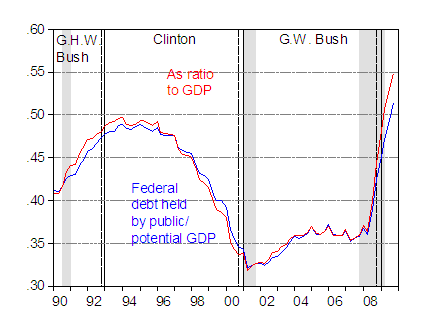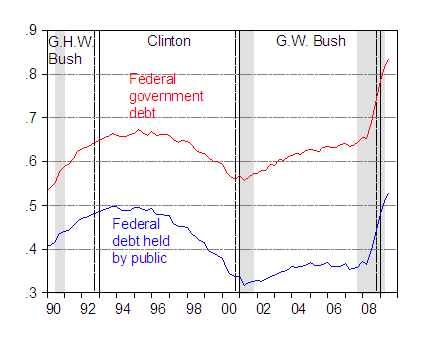Augmenting my previous post, here are two additional graphs, motivated respectively by comments by Econbrowser readers Eric Swanson (for Figure 1) and Cedric Regula and tim kemper (for Figure 2).

Figure 1: Federal debt held by the public as a share of GDP (blue) and as a share of potential GDP. NBER defined recessions shaded gray; assumes last recession ended 09Q2. Vertical dashed line at last Q4 of each Administration, solid vertical line at Q1 of beginning of each Adminisration. Sources: Series FYGFDPUN from St. Louis Fed FREDII, with 09Q4 data from CBO, and BEA, 2009Q4 advance release, CBO (January 2010), NBER, and author’s calculations.

Figure 2: Federal debt held by the public as a share of GDP (blue) and Total Federal debt as a share of GDP. NBER defined recessions shaded gray; assumes last recession ended 09Q2. Vertical dashed line at last Q4 of each Administration, solid vertical line at Q1 of beginning of each Adminisration. Sources: Series FYGFDPUN, series GFDEBTN from St. Louis Fed FREDII, and BEA, 2009Q4 advance release, NBER, and author’s calculations.
Ah, much better. Now if I can just get Krugman to do it that way.
He’s been saying lately he is getting depressed about the anemic level of government spending, and I think if he would draw his curves better, that should cheer him up!
Of course this still doesn’t include anything for Uncle SIV, being writedowns/revaluations of Fed balance sheet, Fannie, Freddie and FHA. But I guess we need to wait for the CBO to push for some resolution of that issue.
Remember, this short term debt is going up because of Temporary variables.
1) The Depressions itself, causing lost tax revenue.
2) The Stabilizer Programs: Unemployment …, which if not there would have allowed the Depression to spiral deeper.
But it’s nice to see your ignoring the real cause of the Depression: Corporate FRAUD. Let’s keep kissing that Wall Street *** and get a SECOND Depression Soon by allowing the Top 1% to CONTINUE TO DESTROY THIS COUNTRY.
Debt to GDP ratios are misleading. It is the volume of current savings (gross private savings and international investment), offered in the market place (including debt monetization), which determines how the Federal budget deficit is managed.
Question:
The Federal deficit is reported as $1.4 trillion, when in fact the gov’t borrowed an additional $.5 for the “off budget” Iraq/Afghan thing. Thus the Fed gov’t borrowed 1.9 trillion, in spite of what they report as the deficit. Do the above grafts account for this misdirection/deception?
Bryce,
They do, because these are total debt, not annual deficits, and the CBO says that “off budget” wars still count.
Menzie,
Great graphs. They demonstrate why Bush left the White House after his second term with one of the lowest approval ratings in history and why Obama will probably do the same after his first term.
Amen Ricardo. Menzie, thank you for graph 2.
Why do the graphs cover only the past two decades?
Why not the past century? Or at least the past seven to eight decades when contemporary GDP computations have been made?
As to who creates the budget, that would be the president in office at the beginning of the fiscal year which currently is Q4 thru Q3, before 1976 was Q3 thru Q2.
Of course, such things as wars and bubble inducing tax policies (reduced short term capital gains tax rates) will impact the budget quarters and even years later.
After all, one might think the economy was really doing fine in 2006 based on the debt burden so surely the Republicans would retain control of Congress based on their fiscal conservatism and the high growth in employment and GDP as a consequence of the tax cuts to promoted higher employment than during the Clinton recession. And I’m positive the analysis of the 2004 election results concluded the conservatives had established a lock on the Federal government to rival that of liberals from 1930 to 1980.
mulp: I could’ve plotted a longer series at the cost of readibility (remember this discussion of when to put the vertical lines). I’ve also I’ve provided the links to the data series. Some go back to only 1970 (FYGFDPUN), some back to 1966 (GFDEBTN), at a quarterly frequency. That should answer your questions. In any case, there is a longer annual time series plotted in this post (which I mentioned in the comments). If you want to dig up the series, and send them my way, I would be much obliged, as I have limited time myself.